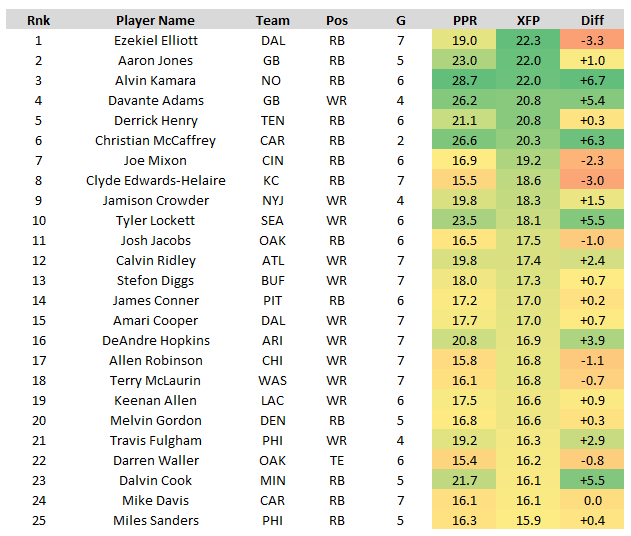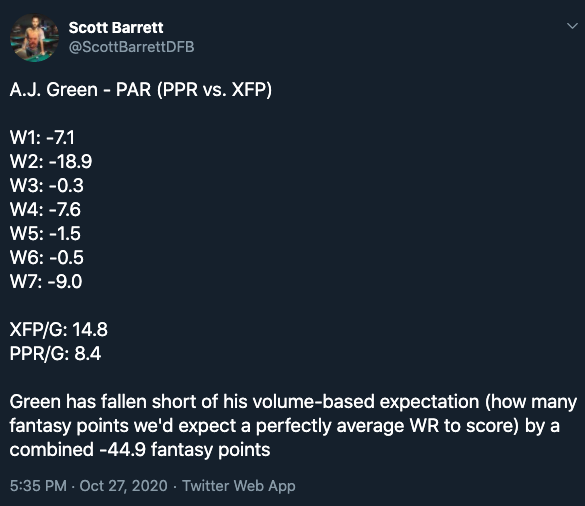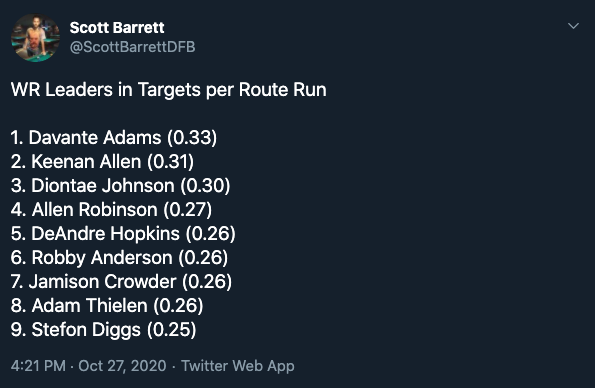Hello, and welcome to the Week 8 XFP Report. If you’re unfamiliar with XFP, I’ll get to that in a little bit.
But basically, every week we’re going to be telling you which players are seeing the best volume for fantasy, as measured by Expected Fantasy Points (XFP). We’ll be telling you who the best buy-low and sell-high candidates are, as measured by Points Above Replacement (PAR), or the differential between actual- and expected fantasy points. This is an especially effective approach in DFS, where players are typically priced by production rather than volume, though PAR will regress to the mean. And (at the end of the article) we’re going to be telling you who the best volume-per-dollar DFS plays are.
What is XFP?
Premium subscribers can access XFP (and other advanced stats like air yards, deep targets, end zone targets) here.
Expected fantasy points (XFP) is flat-out the best and most comprehensive way of measuring a player’s volume. It’s telling you – based on a player’s unique usage – how many fantasy points that player should have scored. It’s telling you how many fantasy points a perfectly league-average RB, WR, or TE would have scored with that same exact volume. It looks at every individual carry by down and distance and distance from the end zone and every individual target by depth of target and distance from the end zone, and then cross-references each carry and target to each carry and target with those specific qualifiers over a multi-year sample to tell you what exactly those carries and targets are worth (historically).
Expected touchdowns (XTD), same thing. RBs score from the one-yard line on 54% of their attempts. RBs score from the 17-yard line only 3.6% of the time. So why ever use “red zone carries,” which treats both carries the same, as a fantasy stat? I have no idea.
Why doesn’t everyone point to XFP in their fantasy research? I have no idea. Once you have XFP and XTD you can contrast that with a player’s actual fantasy points or actual touchdown total to tell you how efficient a player has been (PAR). This is especially useful in highlighting regression candidates, buy-low targets, and mispriced players for DFS.
Through three weeks of action, here are the top-25 players in expected fantasy points (XFP) per game:
The Top-25
A.J. Green, WR, Cincinnati Bengals
PPR: 8.4, XFP: 14.8, PAR: -6.4
Oh boy. Here we go again, huh?
Over the first two weeks of the season, Green ranked 1st among all WRs in total XFP (42.0). Over the last two weeks, Green ranks 2nd among all WRs in total XFP (42.3). Across Cincinnati’s three games in the middle of that sample, Green ranked 50th (19.4).
Okay, so Green is back to seeing good volume, but he’s also still not doing much with it, falling below expectation in every game thus far. He’s far-and-away our top (positive) regression candidate by XFP, which also means he’s the least-efficient player in fantasy, falling a combined 44.9 fantasy points below his expectation.
But Green has performed so poorly on his good volume that we have to ask ourselves – is Green a regression value or a regression trap? With Tyler Boyd (+2.0) and Tee Higgins (+1.6) so much more efficient with their volume than Green (-6.4), the obvious question is – “Why even target Green?” Maybe volume starts to tilt even more in favor of Boyd and Higgins in the coming weeks, or maybe Green surprises us all and returns to former glory. Unfortunately, at age 32 and after a 1.5 year absence from football, I’m not too optimistic.
Diontae Johnson, WR, Pittsburgh Steelers
PPR: 13.1, XFP: 14.4, PAR: -1.3
Johnson was one of our must-draft players this offseason, but it’s been a rocky start. Johnson tanked our cash lineups in Weeks 3 and 5, running a combined 14 routes before exiting both games early due to injury. But across his three healthy games thus far, he’s been even better than expected.
Throwing out Weeks 3 and 5, Johnson is averaging: 21.3 FPG, 21.1 XFP per game, 13.0 targets per game, 1.7 red zone targets per game, and 2.0 end zone targets per game. For perspective, among WRs, those numbers would rank: 3rd, 1st, 1st, 2nd, and 1st. In Weeks 1, 2, and 7, Johnson finished 14th (17.0), 6th (20.3), and 3rd (26.0) among all WRs in XFP.
It's notable that Tennessee used Malcolm Butler to shadow Chase Claypool in Week 7, so maybe they were viewing him as the WR1, forcing Ben Roethlisberger to focus on Johnson in the better matchup. But Butler also isn’t really a CB we’ve come to fear – he ranks bottom-15 of 80-plus CBs in yards allowed per snap in coverage, and ranked even worse in each of his previous two seasons.
Of course, Johnson also left Week 7 early due to injury, so keep an eye on his status for Week 8.
Tyler Lockett, WR, Seattle Seahawks
PPR: 23.5, XFP: 18.1, PAR: +5.5
Lockett scored 53.0 fantasy points on a 37.2-point expectation in Week 7. Both were the highest marks by any player in any game thus far. His 28.1-point expectation in Week 3 was the 7th-highest-mark by any WR this season, just behind DK Metcalf’s Week 5 (29.3). Lockett also had the highest XFP outing in all of 2019, totaling 34.1 XFP in Week 9, while also scoring 40.2 fantasy points. Across his other four games this year, he averages just 10.8 XFP per game.
Metcalf has been similarly boom-or-bust (volume-wise, but not production-wise). Outside of Week 5, he’s averaging just 10.8 XFP per game. But he’s been incredibly efficient, averaging 17.8 FPG over that span, going 7.0-points over PAR in 4 of those 5 games.
Davante Adams, WR, Green Bay Packers
PPR: 26.2, XFP: 20.8, PAR: +5.4
Adams has scored 41.6, 6.6 (hurt), 12.1 (Carlton Davis shadow), and 47.6 fantasy points through four games this season. He totaled 34.2 XFP in Week 1 and 29.9 XFP in Week 7, the 2nd- and 4th-highest XFP outputs from any WR this year.
If we just throw out Week 2 due to injury, Adams is averaging an absurd 26.3 XFP per game and 32.8 FPG, which easily leads all players at all positions.
Adams is $8,800 on DraftKings, which is expensive, but maybe not expensive enough. After Week 10 last season, Michael Thomas had an average salary of $9,214, ending at $9,900 in Week 17. Adams was almost never drafted before Thomas in redraft leagues this offseason, and we’re still not viewing Adams similarly to 2019 Thomas, but maybe that’s a mistake. And especially with Aaron Rodgers looking the best we’ve seen him since maybe 2016.
Since 2018, Thomas averages 21.1 FPG, hitting 16.0 fantasy points in 70% of his games. Adams, meanwhile, averages 20.9 FPG, hitting 16.0 fantasy points in 81% of his games. And Adams also averages more targets per game over this span (11.0 vs. 10.2).
Jamison Crowder, WR, New York Jets
XFP: 18.3, PPR: 19.8, PAR: +1.5
Say what you want about Adam Gase, but the man knows how to get his starting slot WR fantasy points – in fact, it’s the only thing he’s ever done well. Through 4 games, Crowder ranks 2nd in XFP per game (18.3) and 6th in FPG (19.8). He finished 2nd among all WRs in XFP in Week 6 (22.7), before sitting out Week 7 due to injury, and after prior finishes of 19th, 16th, and 8th. Even across his 3-game absence, slot WR Braxton Berrios averages 13.9 FPG. Crowder saw 13 targets in Week 6 (hitting double-digit targets in every game thus far), but scored just 11.8 fantasy points, after 3-straight 100-yard games.
Las Vegas Raiders
Someone in Discord asked for a write-up on the Raiders, so here it is:
Josh Jacobs leads the team in XFP per game (17.5). In victories he’s averaging 21.5 XFP per game, and in losses just 13.4. That’s the difference between him ranking 4th and 22nd at the position. Basically, he is who we thought he was – the same massively gamescript-sensitive player he was last year. They’re 2.5-point underdogs this week against the Browns, so expect something in the middle of those two numbers this week.
Darren Waller isn’t too far behind Jacobs, averaging 16.2 XFP per game, maintaining 21.9% of the team’s XFP. Both numbers lead all TEs, and would rank top-12 among WRs.
After Jacobs and Waller, no one really comes close. Hunter Renfrow ranks 3rd (7.4), Henry Ruggs ranks 4th (6.7), and Nelson Agholor ranks 5th (5.7) on the team in XFP per game. Ruggs is a decent high-ceiling boom-or-bust play for tournaments, but he’s not seeing good or consistent volume. Agholor led the team in targets (9, tied with Waller) and routes last week (34), though he split routes from the slot 13-13-9 with Renfrow and then Ruggs. So, unfortunately, the slot WR-role is still murky – their Week 8 matchup (Cleveland), is giving up the 2nd-most FPG to opposing slot WRs.
Other / Notes
- As we’ve seen since 2017, there’s a Big-3 at the TE position, and then a steep dropoff. This year, it’s Waller (16.2), George Kittle (14.9), and then Kelce (13.6) by XFP per game. Or, Kittle (18.4), Kelce (17.2), Waller (16.2) by FPG. After that, no one really comes close.
- Last week, with Chris Thompson out, James Robinson earned 100% of the team’s XFP out of the backfield and 41% of the team’s total XFP. Both numbers led all players at all positions. He totaled 22 of 22 carries and 6 of 6 targets out of the backfield, while playing on 90% of the snaps. He’s a full-on (Mike Davis-level) bell cow in Week 9 if Thompson sits again (Week 8 bye).
- Denzel Mims saw 7 targets and 12.1 XFP in his Week 7 NFL debut, but as a percentage of the team’s total XFP (28%), that ranked 5th-best among all players. I mean, Jamison Crowder is still probably the only fantasy-viable option on this tanking team, but this is at least noteworthy.
- Since Week 4, Travis Fulgham ranks 6th in FPG (19.2). Since Week 5, he ranks 6th among all WRs in XFP per game (19.4). Over this span, he averages 11.3 targets, 128.0 air yards, 2.0 end zone targets, and 1.3 deep targets per game.
- Among all TEs, Rob Gronkowski finished 3rd in XFP in Week 6 (17.1) and 1st in Week 7 (16.6). Over this span, he averages 16.9 XFP, 8.0 targets, 90.5 air yards, 2.0 end zone targets, 1.0 deep targets, 70.0 receiving yards, and 18.0 FPG. If over a full season, those numbers would rank: 3rd, 3rd, 1st, 1st, 3rd, and 2nd among TEs.
- Clyde Edwards-Helaire handled 77% of Kansas City’s backfield XFP from Weeks 1-6. In Week 7 (Bell’s first game average), that dropped to just 59%. For perspective, a drop from 77% RB XFP to 59% RB XFP is worth about 4.4 XFP per game. That’s the difference between Ewards-Helaire ranking 7th and 20th in XFP per game (19.0 vs. 14.5). However, if adjusting for the blowout (the starters getting pulled and DeAndre Washington coming on in relief), it was true 80/20 XFP split between Edwards-Helaire and Bell. That said, it was much closer in terms of actual playing time, with Edwards-Helaire out-snapping Bell just 27 to 17.
- Kareem Hunt earned 97% of the team’s backfield XFP in Week 7, which ranked 2nd-best among RBs. He ranked just 10th in total XFP (16.0), totaling 18 carries, 4 targets, and 19.2 fantasy points. His day could have been quite a bit bigger, but Cleveland needed to lean pass-heavy to catch up to the Bengals. And his two other games without Nick Chubb can be easily explained away by the fact that those games came against two of the top-5 toughest defenses against opposing RBs. Look for a big Week 8 from Hunt, against a Raiders defense that’s giving up the 3rd-most FPG to opposing RBs.
- Similarly, Mike Davis remains a great play for however long Christian McCaffrey sits out. He flopped last week in a tough matchup, but still totaled 96% of Carolina’s backfield XFP (4th-most). He ranks 5th in XFP per game and 6th in FPG (20.3) since Week 3.
- Jamaal Williams (90% RB XFP%), Giovani Bernard (88%), and Boston Scott (72%) also saw bell-cow workloads in Week 7 with the starter out.
- Ronald Jones, meanwhile, saw his RB XFP% dip from 91% (Weeks 4-6) to 41% in Week 7 with Leonard Fournette back. Per Arians, Fournette is now “the nickel RB”, “playing in hurry-up and obvious passing situations.” Still, there’s some incongruence here. If he’s really just the team’s scatback, why is it that he out-totaled Jones 16.5 to 12.7 in XFP in Week 7, in a game Tampa Bay won by 25 points?
- Over San Francisco’s past three games, Brandon Aiyuk totals 7, 3, and 6 targets and 102, 41, and 107 air yards. Deebo Samuel (out for Week 8), totals 5, 6, and 8 targets over this span, along with -14, -20, and 79 air yards. I’m only pointing this out because San Francisco draws Seattle this week – the ultimate WR matchup. They’re giving up a league-high 23.1 schedule-adjusted FPG to opposing WRs, which is more than double the next-closest defense. Kendrick Bourne – 1, 3, and 4 targets / 4, 36, and 22 air yards – isn’t really in play.
Top DFS Values (DraftKings)
1. Albert Okwuegbunam, TE (4.0X)
2. Denzel Mims, WR (3.8X)
3. A.J. Green, WR (3.3X)
4. Jeff Smith, WR (3.3X)
5. Jamison Crowder, WR (3.2X)
6. Chris Hogan, WR (3.1X)
7. Joe Mixon, RB (3.0X)
8. Aaron Jones, RB (3.0X)
9. Myles Gaskin, RB (3.0X)
10. Melvin Gordon, RB (3.0X)
11. Darren Waller, TE (2.9X)
12. Clyde Edwards-Helaire (2.9X)
Top DFS Values (FanDuel)
1. Jamison Crowder, WR (2.9X)
2. Myles Gaskin, RB (2.7X)
3. David Montgomery, RB (2.7X)
4. Joe Mixon, RB (2.6X)
5. Aaron Jones, RB (2.6X)
6. A.J. Green, WR (2.6X)
7. Tyler Lockett, WR (2.5X)
8. Clyde Edwards-Helaire, RB (2.5X)
9. Melvin Gordon, RB (2.5X)
10. Allen Robinson, WR (2.5X)
11. James Conner, RB (2.5X)
12. Denzel Mims, WR (2.5X)
XFP Market Share Leaders











